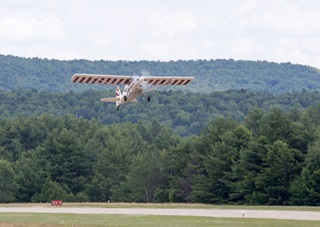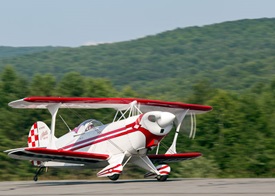
Four minutes in the aerobatic box at a contest can cost thousands of dollars. If my wallet were a living thing, it would run screaming every time and hide under the couch.
It’s not the competition flight itself, but all the seat time that goes into preparing for it, topped off with the entry fee, hotel bill, and sundry extras. Flying a contest will set you back $1,000 at least, and can be much more. It is probably no accident that many contests organized by chapters of the International Aerobatic Club include free food in some form, snacks at least and often entire meals. It keeps some of us from starving to death. These are my $1,000 hamburgers.
Good news arrived this week in a phone call from Eric Forsythe at Four Winds Aviation in McKinney, Texas, just south of the home of the U.S. National Aerobatic Championships, where I will soon learn what fruit my money and time will bear. (Entry fee: $400. Unclear to me so far if that includes all the bottled water we can drink, and perhaps a lovely fruit plate. A nice brisket, perhaps?)
The good news: Forsythe said there should be at least three pilots sharing the Super Decathlon I’ll be flying at the contest. They will most likely be my competition in the Sportsman category, but I welcome them with open arms. We’ll share the cost of getting the airplane to and from its home base, and that probably won’t even amount to an hour, Forsythe said: three tenths of an hour, more or less, each way. That may sound like a trifle, but every little bit adds up.
Regional contests I’ve flown this year were much more costly in that respect: I shared an Executive Flyers Aviation Super Decathlon in August, and still paid more than $700 for less than an hour in the box. I’ve rarely paid much less for the contest rental, and sometimes more. Depending on distance and geography, the ferry cost adds up. Then there is lodging, ground transportation, food. Rental cars are often shared, packed full of people and bags.
Some of my fellow Chapter 35 members are flying their own airplanes to Texas, trips that will span 20 hours or more. Just the avgas alone will add up fast.
With crying towel gripped firmly in hand, I did a little math. With two contests flown this year to date, a grand total of 10.3 hours of solo flight and 16.8 hours of dual instruction, I've spent about $6,500 on the airplane and instructor rental (and could use a lot more practice than I've had.)
Add to that a shiny new helmet purchased after watching Sean D. Tucker describe his bailout in this 2006 video, the takeaway from which was that even the best pilot in the most favorable circumstances can take a pretty hard knock to the skull while bailing out of an airplane. Since a parachute does little good if you’re not awake to deploy it, I plunked down just under $1,000 with a whimper.
All told, the cost of my little hobby is fast approaching (and will almost certainly exceed) $10,000 for the year. (Not a soul has expressed interest in sponsoring that, though I do have space available on that helmet for any number of stickers. Hint, hint.) Which probably explains why some pilots who buy their own aerobatic machine opt to self-educate. To me, this is a bit like DIY brain surgery, though much depends on what the rest of one's logbook holds. A skilled instructor probably pays his or her own way in any case, reducing the seat time required to reach a given level of proficiency. And they can also save your bacon along the way.
The tab I’m racking up pales in comparison to what the very best pilots must pay just to keep up with international competition. Mike Heuer, president of the International Aerobatic Club, said the nine pilots who represented us in the World Aerobatic Championships probably had to come up with a cool half-million between them, including the exorbitant cost of shipping airplanes across the Atlantic. That also included professional coaching partially covered by fundraising, though by no means entirely, and many hours of practice time. That does not include the decade or more of regional and national contests, or aircraft that cost $250,000 or more and are difficult if not impossible to rent.
“They did it without hesitation,” Heuer told me. “Nobody complained. They made that commitment and they followed up on it. That really impressed me.”
Me, too. My wallet would jump in the river and try to swim for it at the slightest hint I want to move up to Intermediate. (Shhh.)
It takes dozens of contests and a high-powered airplane to reach the rarefied air of Unlimited competition, as well as hundreds of hours of seat time. “Imagine the money,” Heuer said. “Just imagine it.”
Some of us can’t help ourselves. Glen Becker, a new friend I met at the Kathy Jaffe Challenge, was flying his first contest in his very own Pitts. We compared notes, agreeing that while the price of the sport is very high, what we get out of it is worth enough to justify the sacrifice and single-minded pursuit of ever-elusive aerobatic perfection.
A Pitts Special, depending on the model and year, can be had for as little as $25,000 if you’re patient and willing to compromise on power and propeller, among other factors. There are many in the $50,000 range.
"You’ll have more fun than you’ve ever had in your life in a Pitts," Heuer said. "Even S-2Bs aren’t outrageous … you can have you a hell of a good aerobatic airplane at a pretty reasonable price."
A Super Decathlon in reasonable shape is probably in the low six figures. The other good news from Texas was that Four Winds rents their 8KCAB for a very reasonable $160 an hour. In the Boston area, they fetch $225, so much depends on location. I’ve heard tales of lucky pilots who found absentee owners willing to share their airplanes for a pittance, eager to have them exercised. And some owners out there will rent well below market rates to support the sport. (No, I will not name any names. Sorry.)
What we get out of competition is as much about what we put into it in terms of time and effort and sheer desire as it is about what the bank statement says at the end of the month: Confidence, precision airmanship, aeronautical competencies that many pilots never achieve, and, for a lucky few, a nice wooden plaque or shiny medal to mount conspicuously in a spot where it can spark conversation. I encourage every pilot to give it a try—particularly those of you of a mind to share a Super Decathlon with me.

Why we fly figures
My friend Wes Liu, who has been deeply involved in competition for decades and flies a Pitts S-2A that I secretly covet, recently shared with me his own rationale for devoting so much to a few minutes in front of judges. His list, in its entirety:
10. I’ve seen all of the $100 hamburgers—twice.
9. ATC does not issue “atta-boys” for a perfectly flown ILS.
8. Cessna/Piper/Mooney/Cirrus owners don’t hang together and compare how their ships fly.
7. Flying to one of the exotic destinations shown in the magazines to sit around and consume fruity drinks with non-flyers is boring. I like destinations with action, preferably aviation action that I can participate in.
6. It takes 20 minutes to get the G1000 in a Cessna set up. In my Pitts Special acro ship, it takes 2 minutes to power on the comm and transponder, run the checklist, and call Ground for taxi.
5. My primary flight instructor showed me approaches to stalls and that’s all. He seemed nervous coming down final when the indicated airspeed got down to 1.3 Vso. Aerobatics taught me how to maneuver when the airspeed indicator reads zero, as well as how to do spins and falling leafs.
4. An aerobatic contest is a fly-in where everyone is either flying or judging and they post how well you did on the wall for everyone to see. It’s up to you whether you are a hero or a zero. But whatever you make yourself, you are accepted as a competitor.
3. An aerobatic contest is a place where, for the 4 minutes that you own the competition arena, the box, and you don’t have to worry about FAA rules, just the laws of physics.
2. You climb into the airplane and compete with yourself. The only score that you can control is your own. Flying better than your peers is incidental.
1. Medals and trophies reinforce that you outflew your peers today. Tomorrow is another day. You need to fly more to stay ahead. Another excuse to go fly more.
I fly aerobatics because I can. Challenge yourself.
Wes Liu



